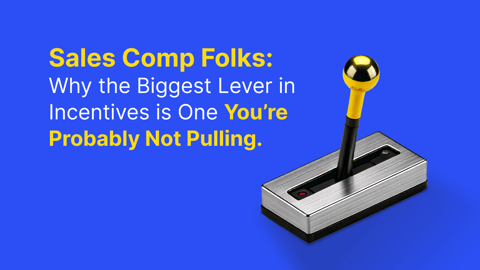So how do we get alignment from here?
The solution sounds obvious, but it’s tough to pull off in practice – and that’s to get everyone in the same room and have them talk to each other.
At Varicent, we’ve designed a program to help with this. It’s called the Silo Breaking Workshop. The goal is to increase alignment between marketing sales, improve conversion rates, and drive revenue. We’ve run it with dozens of companies, and now we’re sharing how you can do it with your team.
This is something you can do today, with the resources you already have, and will change your trajectory for 2020.
Why you need a Silo-Breaking Workshop
If you’ve read the Measurable Lead Model, you know the problem really starts with the term MQL – it has “Marketing” in its name and immediately changes the conversation to how we measure marketing’s contribution to revenue. To learn more about this, read the Measurable Lead Model, which we’ll reference throughout this post.
This language is important – with companies we work with, we’ve found that Marketing has a definition of what an MQL is, and Sales has a definition of who they sell to. In theory, those two things should line up exactly, but in most cases, they don’t.
Try it out with your own team: ask someone in Marketing what an MQL is. Ask someone in Sales. Ask a few folks who sit beside each other! You’re likely to get very different answers.
The impact is huge
We have run the Silo-Breaking Workshop with a number of our software customers and have seen results impact the way they do business in many different ways.
Here are a few examples:
- Ensure all leads are worked
- Reduce lead response times
- Reduce funnel leaks at handoffs
- Ensure prospects enjoy a fast, smooth qualification process that doesn’t waste their time or yours
Improve nurture model
Recycle leads rather than drop them
Adopt a nurture model that addresses the reasons the buyer is not ready - yet
Adopt clear language that all employees understand including new team members. This single change will improve efficiency across sales, marketing, and success.
Customer Example #1
Problem:
Only about 25-30% of MQLs were being worked by the sales team and it was unclear why.
A few theories were:
- Not enough sales reps to keep up with the leads
- Too many unqualified prospects were making it through
- Sales Reps are cherry-picking or need coaching
Solution:
The Silo-Breaking Workshop helped the company identify:
- Existing customer leads were being routed to SDRs, not CSMs, which led to missed expansion opportunities and using up SDR capacity.
- Almost any web action was leading to an MQL – the criteria was too broad which led to sales reps cherry-picking to a specific segment that worked better for the comp model, but not for the business targets.
- There was no clear path for recycling leads, any “bad” lead was marked unqualified – whether it was a job seeker or a good lead that just wasn’t in a buying cycle, making it nearly impossible to effectively nurture leads.
Customer Example #2
Problem:
A high-growth tech company, the sales team had doubled in size two years in a row. In that time, they organically built out multiple territories, new segmentation, new teams that handle renewals – you get the idea, but revenue growth hit a wall despite lead numbers increasing.
Solution:
The Silo-Breaking Workshop helped the company identify:
- Ad-hoc segmentation and territory alignment had shifted into a new model they could formalize into a system moving forward, and leave behind the baggage of band-aid solutions that had cropped up as the business needs evolved over the years.
- Complex routing rules, account ownership rules, and rules-based ownership got thrown out to simplify everything (like recycling leads to the owner from the last sales attempt, even if the territory/segment shifted since).
- There was a huge disconnect between how Marketing, SDRs, and AEs were all qualifying opportunities that were resolved fairly quickly in open discussion, creating new criteria for qualification, nurture, and removing bad leads from the funnel.
Customer Example #3
Problem:
A SaaS company had grown fast (70-90% YoY growth) on inbound leads and scaled up the sales development organization quickly into specialized inbound and outbound teams. However, the team viewed their leads as a linear funnel – they didn’t have a concept of recycling leads, which left the majority of Marketing efforts untouched.
Solution:
The Silo-Breaking Workshop helped the company identify:
- 98% of leads don’t buy from you on the first sales attempt – the company started tracking nurture reason and loss reason that could be connected to nurture programs, refactored Marketing’s approach to nurture, and started to have the outbound team call into abandoned inbound leads every 6 months after the last sales attempt
- The systems team had issues with re-routing leads and contacts to the right reps; there were multiple owners stored on each object leading to confusion for who was responsible for a lead at any given point in its lifecycle
- The SDR team was being managed through status changes in Salesforce, but using automated sequences to track follow-ups. Due to system migration issues, many touchpoints weren’t being completed, but it appeared they were due to the way statuses were used for reporting.
That’s why it’s so important to get Marketing, Sales, and Operations aligned, communicating, and working towards to same goals.
To do that, we like to run something called the “Silo-Breaking Workshop”.
Who to have in the room
This is an expensive meeting. You need representation from four teams in the room: Sales, Marketing, Operations, and Leadership.
Sales
Your sales reps are closest to the buyer – and the people who have to work these leads. You need their perspective and buy-in. It’s tempting to keep sales reps working, but they’re the ones with the answers.
- 1-2 SDRs
- 1-2 AEs
- VP of Sales
Marketing
- VP Marketing / CMO
- Demand generation
Operations
It’s important to have all these teams involved because they all have completely different perspectives on the funnel and your buyer, and each have a stake in executing this work after the workshop.
If you see this as a useful exercise, but don’t want to bring certain people or teams off of what they are working on to participate, you’re not going to achieve what you want out of the workshop. Everyone needs to be involved, have a voice, and hear each other out.
The facilitator
When it comes to running the workshop, the best option is to find a third party facilitator – like a board member, advisor, or outside consultant
The facilitator can ask questions without political consequence or motivation – but if your team members ask the same questions, it could feel like you’re poking the bear. Third-parties don't have in-depth knowledge about how your funnel works, so everyone has to explain it to them like it's brand new – and they’ll explain it in a way that’s different than if they're explaining it to a co-worker.
Questions to ask
The workshop is interview driven. The goal is to ask time-based questions about your funnel, leaving all acronyms at the door, and document it as you go. Don’t be afraid to follow the random sidebars as that is where the good insights usually come from.
Time-based questions follow the structure of your funnel, but without a funnel model:
- Who do you sell to?
- What does a prospect do that tells you a sales rep should work them?
- What questions do you need to ask prospects to determine if they’re a fit to buy from you?
- What criteria does a prospect need to meet to hand-off to an AE?
- When you get in touch with a lead, what tells you that you should create an opportunity?
- Why do you win opportunities?
- Why do you lose opportunities?
- Do you ever win opportunities that you lost on the first sales attempt?
Setting the stage with workshop rules
It’s important to set the stage properly for this workshop, and there are three main things you need to get across to the workshop participants:
-
Future state - this is about how it should work, not how it works today.
-
No blame - it doesn’t matter how we got here, it matters what we’re going to do about it.
-
Be open - be brutally honest about what’s working (and not working)
One more rule to follow: No acronyms
The point of this exercise is to answer questions like who we sell to, when we sell to them, how we sell to them, and why we sell to them in plain English – that means no acronyms.
To do that, we recommend using time-based questions. Here are some examples:
- When should a lead be assigned to a sales rep to work?
- When a lead comes in, what tells you you’re going to work that lead?
- When you talk to a prospect, what tells you they're going to buy from you now, not now?
Using time-based questions will force you and your team to think differently about your funnel asking for definitions of things that already have meaning in your business (like MQL, SQL, etc.) When you ask, "What tells us someone's going to buy now,” opens up the discussion much more and lets you have meaningful conversations about what is happening in your deals.
Instead of asking:
- What’s an MQL
- What’s an SQL
- What is an abandoned lead
- What is a Nurture lead
Ask:
- What needs to happen to handoff a lead from Marketing to Sales
- What scenarios exist where you abandon a lead
- What scenarios exist where you’d send a lead to nurture



